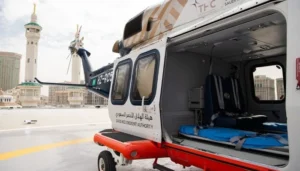Saudi Arabia successfully conducted an air ambulance landing test on the Grand Mosque’s newly constructed helipad in Makkah. The initiative aims to enhance emergency response capabilities and ensure rapid medical assistance for pilgrims and visitors. The test was carried out under the supervision of the General Presidency for the Affairs of the Grand Mosque and the Prophet’s Mosque in collaboration with emergency medical services.
With millions of worshippers visiting Makkah each year, the introduction of an air ambulance service marks a significant advancement in medical preparedness. The helipad’s strategic location enables swift evacuation of critical patients to specialized hospitals, reducing response times during medical emergencies. This development aligns with Saudi Arabia’s broader efforts to improve healthcare infrastructure, particularly during peak pilgrimage seasons such as Hajj and Umrah. Authorities have assured that the helipad will be fully operational soon, reinforcing the Kingdom’s commitment to ensuring the safety and well-being of all visitors to the holy city.
Landmark Air Ambulance Test at the Grand Mosque

In a historic move, Saudi authorities successfully conducted an air ambulance landing test on the helipad of the Grand Mosque in Makkah. This initiative is part of a broader plan to enhance emergency medical services in one of the holiest and busiest Islamic sites. The test was conducted by the Saudi Red Crescent Authority (SRCA) in collaboration with security and health agencies, ensuring that medical assistance can be provided quickly to worshippers and pilgrims in need.
The Purpose of the Air Ambulance Service
The primary goal of this air ambulance service is to ensure rapid medical intervention for worshippers and pilgrims in case of emergencies, such as heart attacks, heat strokes, and other critical conditions. With millions of people visiting the Grand Mosque annually, the ability to transport patients to specialized medical facilities swiftly could be life-saving. The helipad’s strategic location allows for quick access to key hospitals in Makkah and surrounding areas.
Read more: Shawwal Moon: Eid ul Fitr to Fall on March 31, Says Suparco
Saudi Red Crescent Authority’s Role in Emergency Response
The SRCA, responsible for providing emergency medical services across the kingdom, spearheaded the air ambulance test. The agency has been expanding its capabilities to offer high-quality emergency care, particularly in areas with large crowds. The Grand Mosque is a high-density location, especially during the Hajj and Umrah seasons, making the availability of aerial medical evacuation a crucial addition to its emergency response framework.
Collaboration Between Health and Security Agencies

The successful test involved coordination between the Ministry of Health, the General Authority of Civil Aviation, and security forces. These entities worked together to ensure that the helipad’s location, air traffic control, and logistical arrangements were aligned with safety and operational requirements. Officials emphasized that integrating air ambulance services with existing emergency response teams will significantly enhance the efficiency of medical evacuations.
Challenges of Emergency Response at the Grand Mosque
Due to the sheer number of visitors to the Grand Mosque, providing emergency healthcare has always been a challenge. Factors such as overcrowding, limited accessibility for ground ambulances, and the high risk of medical incidents make rapid medical intervention essential. The air ambulance service is expected to address these challenges by bypassing road traffic and directly transporting critically ill patients to hospitals equipped to handle complex medical cases.
Potential Impact on Hajj and Umrah Pilgrimage Safety
The introduction of an air ambulance service at the Grand Mosque is particularly significant for Hajj and Umrah, as it attracts millions of pilgrims from around the world. The extreme weather conditions, long hours of walking, and physical exertion often lead to medical emergencies. With this service in place, pilgrims suffering from heat exhaustion, dehydration, or heart conditions can receive urgent medical attention without delays.
Advanced Medical Equipment on Board
The air ambulances used for this service are equipped with state-of-the-art medical facilities, including ventilators, defibrillators, and life-support systems. Trained paramedics and emergency physicians will be on board to provide immediate care during transport. The helicopters are designed to accommodate critical patients, ensuring they receive stabilizing treatment before reaching a hospital.
Future Plans for Expanding Aerial Medical Services

Following the successful test at the Grand Mosque, Saudi officials are considering expanding air ambulance services to other key locations, including Madinah’s Al-Masjid an-Nabawi and major transportation hubs. The long-term goal is to integrate aerial emergency medical services into the kingdom’s broader healthcare and disaster response infrastructure, ensuring efficient coverage for all high-traffic religious and tourist sites.
Public Reaction and International Praise
Both local citizens and international Muslim communities have widely praised the launch of the air ambulance service. Many see it as a significant step toward modernizing emergency medical care at Islamic holy sites. Global health organizations and religious leaders have also commended Saudi Arabia for prioritizing pilgrim safety and utilizing advanced technology to improve healthcare access.
Frequently Asked Questions
What is the purpose of the air ambulance landing test?
To evaluate the helipad’s readiness for medical emergency evacuations in Makkah.
Where is the helipad located?
The helipad is situated on the Grand Mosque in Makkah.
Who supervised the test landing?
The General Presidency for the Affairs of the Grand Mosque and emergency services.
Why is this air ambulance service important?
It ensures quick medical assistance for pilgrims and visitors in critical conditions.
Will the air ambulance service be available year-round?
Yes, it will operate continuously, especially during peak pilgrimage seasons.
How does this benefit Hajj and Umrah pilgrims?
It provides a faster medical response, reducing health risks during religious gatherings.
When will the helipad become fully operational?
Authorities have stated it will be functional soon after final evaluations.
What kind of medical emergencies will be handled?
The service will assist with heart attacks, injuries, strokes, and other critical conditions.
Is this the first time an air ambulance landed at the Grand Mosque?
Yes, this marks the first official test landing for emergency medical services.
How does this fit into Saudi Arabia’s healthcare plans?
It aligns with the Kingdom’s vision to enhance medical infrastructure and emergency response.
Conclusion
The successful test landing of an air ambulance on the Grand Mosque’s helipad signifies a significant step in Saudi Arabia’s commitment to improving emergency healthcare for pilgrims. This initiative will enable faster medical intervention, reducing the risk of severe health complications during religious gatherings. With millions of visitors coming to Makkah annually, the helipad ensures immediate response to critical emergencies, reinforcing safety measures in the holy city. The project aligns with broader healthcare enhancements under Saudi Vision 2030. Once fully operational, this service will provide invaluable support, ensuring the well-being of worshippers at one of Islam’s most sacred sites.

